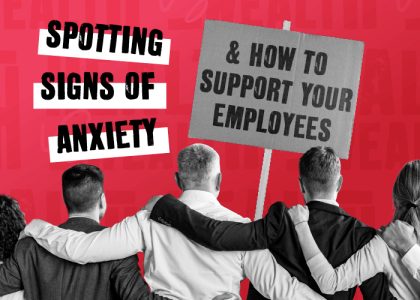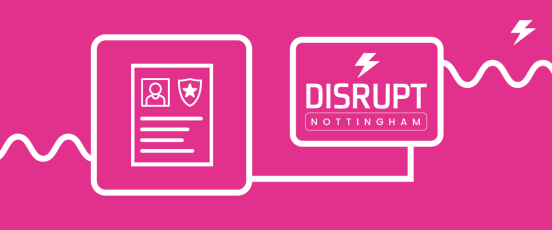Signs of anxiety in employees

Anxiety is on the rise in the modern workplace. How can you spot signs of it in your employees, and give them the tools they need to overcome it?
What is anxiety?
There are technically two definitions of anxiety, and it’s really important we distinguish between them.
There’s anxiety as a feeling. Think about the last time you went into an exam or job interview. You may have felt uneasy, nauseous, or panicky. This is completely normal, and a natural part of life. Anxiety is how our body protects itself when we’re under threat. You may be familiar with the ‘fight, flight or freeze’ response. Anxiety is part of that.
There’s also anxiety as a symptom. When anxiety becomes disruptive to our day to day, this is often a sign of something more significant. These signs could include:
- When the level of anxiety is not proportionate to the situation
- You start to avoid situations that you know might cause anxiety
- The physical symptoms of anxiety become more regular (panic attacks, for example)
- The anxious feelings are much stronger than usual
Anxiety could be a sign of any number of mental health concerns, such as PTSD, phobias, panic disorder or social phobia. It can also fall under its own specific condition, which is called ‘generalised anxiety disorder’ (GAD). Crucially, this is when our bodies act like we’re under threat, when we’re really not.
Anxiety is not the same thing as stress. Stress tends to be short-term and caused by a specific trigger. Remove the trigger and the stress goes away. For example, if a big project at work is causing you stress, when the project ends the stress will reduce. Anxiety tends to be more long term, and the worries tend to be more persistent.
Anyone can experience anxiety, both as a feeling and as a symptom. If someone finds themselves constantly in situations that make them anxious, even if they have no underlying mental health conditions, this can be very detrimental to their long-term health. In the UK, 1 in 10 people live with an anxiety disorder – over 8 million people in total.
Employers therefore should take steps to protect employees from anxiety at work and put steps in place to support them. This will help employees from every background to thrive.
Identifying the signs of anxiety
One of the key things to emphasise is that anxiety can look very different when it appears in different people. Remember, it’s ‘fight, flight or freeze’, and there’s a lot of variances within that. But there are some key signals that you can teach managers and employees to identify in themselves and others as a starting point.
This list should not be seen as a diagnostic tool. If you suspect you have GAD or any other concerns about your mental wellbeing, speak to a healthcare professional.
While anxiety is a mental health concern, it also has a number of physical symptoms as well as emotional symptoms to watch out for.
Physical symptoms
- Nausea
- Light-headedness
- Sweating,
- An irregular heartbeat
- Pins and needles
- Churning feelings
- Sleep problems
Emotional symptoms
- An inability to relax
- A sense of dread
- A feeling that everything has slowed down or sped up
- Paranoia that other people can see you panicking
- Needing reassurance, especially that people aren’t secretly angry at you
- Depersonalisation- which is when you disconnect from your own sense of self
- Spending a lot of time replaying a bad situation over and over again in your head
- Depression
A more complicated symptom that’s one of the more common signs of anxiety at work is called catastrophising. This is when someone fixates on the worst possible outcome of an event. For example, someone catastrophising about a big meeting might panic that the meeting will go wrong, and that if it does, they’ll lose their job. If they lose their job, they’ll never get a new one, and so they’ll starve. Each step does make sense as a potential outcome, but the start and end point are so wildly disconnected that it causes unwarranted distress.
Regardless, someone experiencing anxiety might feel any number of these symptoms. One of the biggest warning signs for anxiety in the workplace is a sudden change in mood or behaviour. If somene suddenly becomes more withdrawn, or pricklier, this could be a sign they’re anxious.
A note on panic attacks
Panic attacks are one of the most famous symptoms of anxiety, and so it’s important to understand them. Panic attacks are a fear response. Your body gets flooded with adrenaline and you will get a rush of intense symptoms. These can include:
- A sense of danger
- A rising heart rate
- Chills or hot flushes
- Chest pain
- Shaking
- Weak legs
- Feeling like they can’t breathe
- Feeling faint
- Nausea, vomiting, stomach cramps
Sometimes panic attacks have an obvious trigger, but often they can come on quickly for no clear reason.
Panic attacks aren’t always visible. While the traditional image is someone breathing heavily, crying, or having symptoms similar to a heart attack, some people go very quiet and still.
If you think someone is having a panic attack, remain calm. It can be a frightening experience- panic attacks can often look like strokes or heart attacks so make sure to educate yourself on the physical symptoms of those conditions. If there is any reason to think it might not be a panic attack, call an ambulance.
Assuming it is a panic attack, don’t dismiss the person or tell them they have nothing to worry about. Often, the person experiencing the attack is very aware that the response isn’t rational, and adding extra embarrassment isn’t going to help.
Instead, help the other person to breathe more slowly. Encourage them to focus on something else, for example asking them to name five objects they can see. Try to be as nonjudgemental as possible. Once it’s over (which will often take between 10 and 20 minutes), you may want to point them to more specialised support.
However, while panic attacks are often what everyone thinks of when they think of anxiety, they are not the be all and end all. Just because someone is not prone to panic attacks doesn’t mean they don’t have severe anxiety.
If someone is suffering from anxiety over the long term, it can have an impact on their work performance. If an employee:
- Struggles to make decisions
- Drinks or smokes more
- Has a noticeable drop in performance
- Takes more sick leave
Then anxiety could be a culprit.
Supporting employees with anxiety
Mental health first aiders are the first line of defence against anxiety at work. They’ll have good training in how to handle acute cases (like panic attacks) and ensuring people know where to go for additional support.
An employee assistance programme (EAP) may also help. They can provide anonymous advice for a range of problems employees may be having, helping reduce anxiety.
Getting mental health services on the NHS is incredibly difficult, and private services tend to cost a lot. Anything you can do to provide extra support will really help your employees.
In the long term, you need to champion a mental health culture within your workplace. That means open door policies that build employee trust, where everyone feels able to share their worries, which is less likely to let anxious feelings fester.
For more on building up a healthy attitude to mental wellbeing in the workplace, take a look at our mental health guide.



